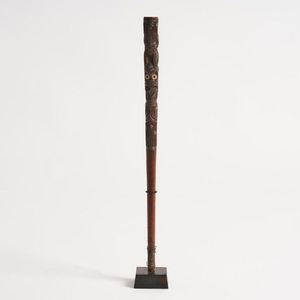Te Arawa Whakairo Rakau with Rare Heni-Ruru Depiction
A Whakairo Rakau, Aotearoa. This whakairo rakau consists of a smooth cylindrical body, fine carving and original lashings with carvings reminiscent of a Whakapakoko rakau or god stick. The top is decorated with a carving style known from the Te Arawa people. Moreover, we have the Takarangi (spiral) displayed with the pakati (notches) broken up into groups. This style has been observed on early Te Arawa whare, war canoes and other carvings. To the front of the rakau, a finely carved depiction of an atua (probably Rongo or the atua of cultivation) is observed with three fingers clutching the belly to depict a bountiful harvest. To the reverse there is an extremely scarce and important depiction of a Ruru (Morepork owl). The Ruru depicts the atua Heni-Ruru (owl woman) who was seen as a kaitiaki (guardian). This rare depiction of Heni-Ruru boasts marine ivory inserts to mimic the eyes of the owl, a beaked mouth and decorations reminiscent of a pukauae (female chin tattoo). Heni-Ruru ensured the crops would be protected (especially at night) from enemies and disease., Directly above the Heni-Ruru we see another carving style typical of the Te Arawa people. This time, a simple spiral consisting of two interlocking arms with a rauponga to the centre is observed. The carved body is prominently concentric lines and notching with some gaps to the notching consistent with a Te Arawa design. To the base we see a fine series of lashings with pegs inserted to prevent the lashings falling off at any time. Height 47 cm, depth 2.6 cm, on stand height 49.8 cm. Registered as Whakapakoko Rakau (God stick). Provenance: Private Collection, Aotearoa. Previously of a private collection, Paris. Previously of a private collection, England for over a century
You must be a subscriber, and be logged in to view price and dealer details.
Subscribe Now to view actual auction price for this item
When you subscribe, you have the option of setting the currency in which to display prices to $Au, $US, $NZ or Stg.
This item has been sold, and the description, image and price are for reference purposes only.
- Ivory - Ivory is a hard white material that comes from the tusks of elephants, mammoth, walrus and boar, or from the teeth of hippopotamus and whales. The ivory from the African elephant is the most prized source of ivory. Although the mammoth is extinct, tusks are still being unearthed in Russia and offered for sale.
Ivory has been used since the earliest times as a material for sculpture of small items, both in Europe and the east, principally China and Japan.
In Asia ivory has been carved for netsuke, seals, okimono, card cases, fan supports, animals and other figures and even as carved tusks.
In the last 200 years in Europe ivory has been used to carve figures, for elaborate tankards, snuff boxes, cane handles, embroidery and sewing accessories, in jewellery and as inlay on furniture. Its more practical uses include being used for billiard balls, buttons, and a veneers on the top of piano keys.
The use and trade of elephant ivory have become controversial because they have contributed to Due to the decline in elephant populations because of the trade in ivory, the Asian elephant was placed on Appendix One of the Convention on International Trade in Endangered Species (CITES), in 1975, and in January 1990, the African elephant was similarly listed. Under Appendix One, international trade in Asian or African elephant ivory between member countries is forbidden. Unlike trade in elephant tusks, trade in mammoth tusks is legal.
Since the invention of plastics, there have been many attempts to create an artificial ivory
This item has been included into following indexes:
- Maori artefacts
